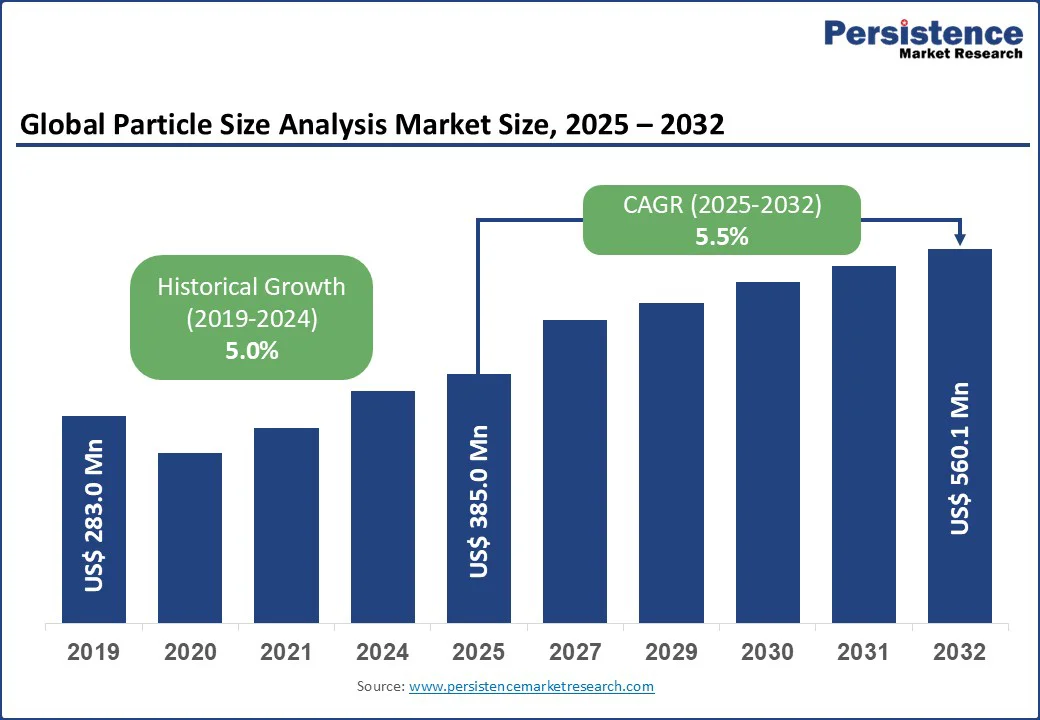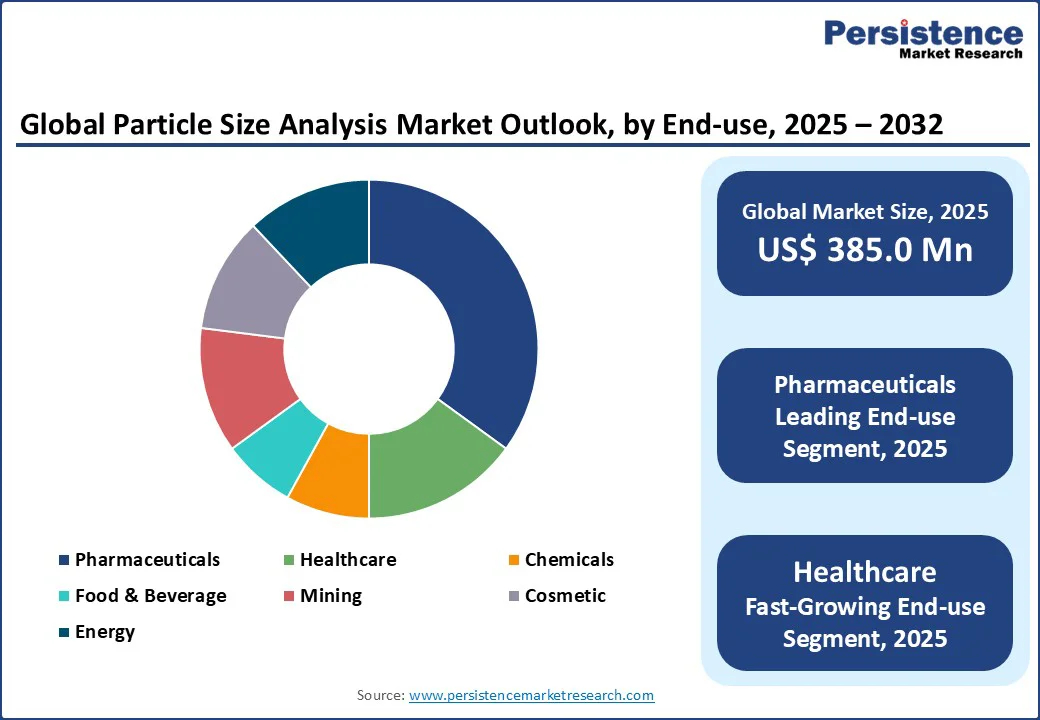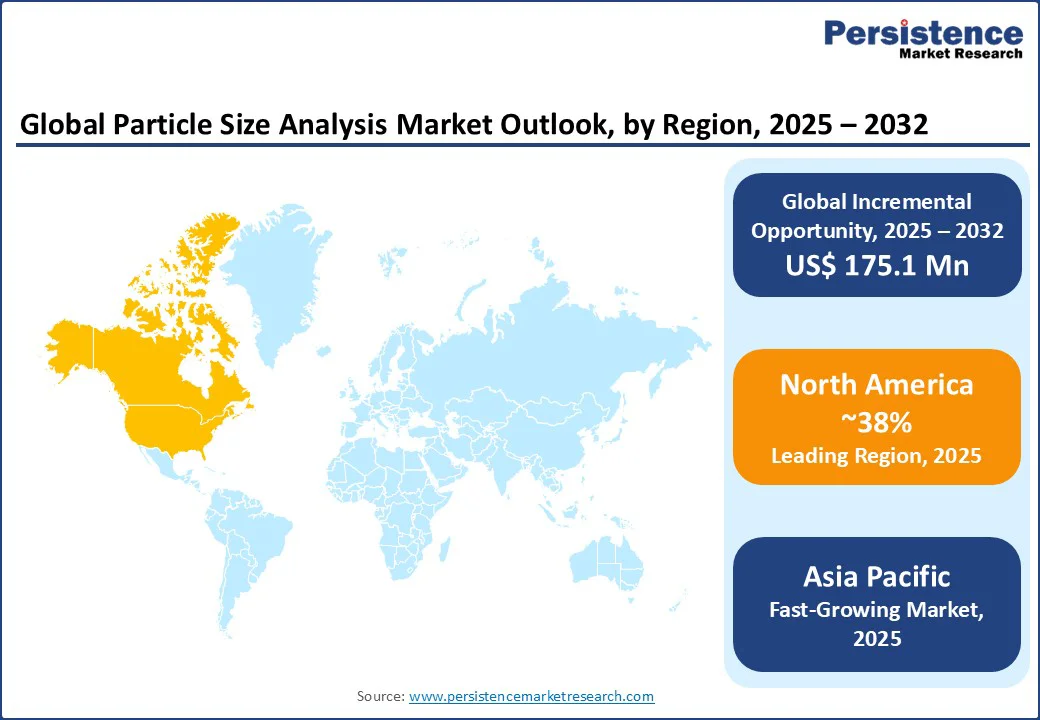ID: PMRREP12640| 192 Pages | 17 Sep 2025 | Format: PDF, Excel, PPT* | Chemicals and Materials

The global particle size analysis market size is likely to be valued at US$ 385.0 Mn in 2025 and is expected to reach US$ 560.1 Mn by 2032, growing at a CAGR of 5.5% during the forecast period from 2025 to 2032 driven by increasing demand for precise material characterization across industries such as pharmaceuticals, healthcare, and chemicals.
Key Industry Highlights:

|
Global Market Attribute |
Key Insights |
|
Particle Size Analysis Market Size (2025E) |
US$ 385.0 Mn |
|
Market Value Forecast (2032F) |
US$ 560.1 Mn |
|
Projected Growth (CAGR 2025 to 2032) |
5.5% |
|
Historical Market Growth (CAGR 2019 to 2024) |
5.0% |
The rising adoption of nanotechnology across diverse industries such as pharmaceuticals, electronics, energy, and materials science is a key driver of the particle size analysis market. Nanotechnology relies heavily on precise control of particle size, as even small variations can significantly alter material properties, functionality, and overall performance. In pharmaceuticals, for example, nanoparticle-based drug delivery systems require accurate measurement to enhance bioavailability, ensure consistent dosing, and improve therapeutic outcomes.
Similarly, in electronics and advanced materials, the efficiency and reliability of nanomaterials depend on maintaining strict particle size standards. To meet these evolving needs, leading companies such as Malvern Panalytical and Horiba are developing advanced solutions, including laser diffraction and dynamic light scattering technologies, that deliver high accuracy and reproducibility. As industries increasingly focus on innovation using nanomaterials, demand for particle size analysis tools continues to grow, positioning market as a critical enabler of next-generation applications and sustainable technological progress.
The high cost of particle size analysis equipment and its upkeep remains a major restraint to market growth. Advanced systems such as laser diffraction and nanoparticle tracking instruments demand significant capital investment, which is often challenging for small and medium-sized enterprises. Beyond the initial purchase, ongoing expenses related to calibration, servicing, and the need for skilled operators add to the financial burden, making these technologies less accessible for cost-sensitive industries.
In developing regions, where budgets for research and quality control are limited, the adoption of such high-end systems becomes even more difficult. This cost barrier restricts the wider deployment of particle size analysis tools, slowing down their penetration in markets that could benefit from them the most. Consequently, while demand is rising across applications, affordability challenges remain a critical factor holding back the full potential of the particle size analysis market.
The development of automated and real-time particle size analysis technologies offers a major growth opportunity for the industry. Automation not only minimizes human error but also improves efficiency and allows for continuous monitoring throughout industrial processes. Real-time systems, provided by companies such as Microtrac and Fritsch, enable manufacturers to track particle size distributions during production, ensuring consistency, quality, and compliance with stringent standards.
The integration of artificial intelligence and machine learning is taking this further by enhancing data accuracy, predictive insights, and process optimization. AI-driven platforms can adjust measurements in real time, reducing downtime and improving throughput in industries such as pharmaceuticals, chemicals, and materials science. As industries across the globe increasingly shift toward smart manufacturing and automation, the demand for advanced particle size analysis tools is expected to grow significantly, opening new revenue opportunities and positioning these technologies as essential components of modern production environments.
Wet particle analysis dominates the particle size analysis market, expected to account for approximately 40% share in 2025. Its dominance is attributed to its widespread use in pharmaceuticals, chemicals, and food & beverage industries, where liquid-based samples are common. Wet particle analysis, using techniques such as laser diffraction and dynamic light scattering, provides high accuracy for suspensions and emulsions, making it ideal for drug formulation and quality control. Companies such as Malvern Panalytical and Beckman Coulter offer advanced wet particle analysis systems that cater to these industries.
The spray particle analysis segment is the fastest-growing, driven by increasing demand in the cosmetics and pharmaceutical industries for aerosol and spray-based products. Spray particle analysis ensures precise measurement of droplet sizes in applications such as inhalers and cosmetic sprays, enhancing product performance and safety. The rising popularity of inhalation therapies and cosmetic aerosols, particularly in North America and Europe, is accelerating the adoption of spray particle analysis systems.
Laser diffraction leads the particle size analysis market, holding a 42% share in 2025. Its dominance is driven by its versatility, accuracy, and ability to measure a wide range of particle sizes, from nanometers to millimeters. Laser diffraction systems, such as those offered by Horiba and Microtrac, are widely used in pharmaceuticals, chemicals, and mining industries for quality control and research purposes. Their non-destructive nature and rapid analysis capabilities make them a preferred choice across applications.
The nanoparticle tracking analysis (NTA) segment is the fastest-growing, fueled by the rising demand for nanoparticle characterization in healthcare and pharmaceuticals. NTA provides high-resolution analysis of nanoparticles, enabling researchers to study particle behavior in drug delivery systems and biomedical applications. The global nanotechnology market’s growth, particularly in Asia Pacific and North America, is driving demand for NTA systems, with companies such as Malvern Panalytical leading innovation in this space.
Pharmaceuticals lead the particle size analysis market, accounting for approximately 35% of revenue in 2025. The segment’s dominance is driven by stringent regulatory standards, such as those set by the FDA and EMA, requiring precise particle size analysis for drug formulation and quality control. Particle size directly impacts drug solubility, bioavailability, and stability, making advanced analysis systems critical for pharmaceutical manufacturers. Companies such as Agilent Technologies and Mettler Toledo provide tailored solutions for pharmaceutical applications.
The healthcare segment is the fastest-growing, driven by the increasing use of particle size analysis in biomedical research and diagnostics. The rise in nanoparticle-based therapies, such as targeted drug delivery and diagnostic imaging, has spurred demand for precise particle size measurement. The global healthcare nanotechnology market, valued at US$ 200 Bn in 2025, is further boosting this segment, particularly in North America and Europe.

North America holds the largest share of the particle size analysis market, accounting for 38% in 2025, with the U.S. being the primary contributor. The U.S. market is driven by its advanced R&D infrastructure, stringent regulatory standards, and significant investments in pharmaceuticals and nanotechnology. The FDA’s emphasis on quality control in drug manufacturing has increased the adoption of particle size analysis systems in the pharmaceutical industry.
Additionally, the U.S.’s focus on nanotechnology research, supported by initiatives such as the National Nanotechnology Initiative, drives demand for advanced technologies such as NTA and laser diffraction. Companies such as Beckman Coulter and Micromeritics are headquartered in the U.S., further strengthening the region’s market position. The growing healthcare sector, particularly in biomedical applications, also supports market growth.
Europe is a significant player in the particle size analysis market, driven by strong institutional support and demand for high-quality manufacturing. Leading countries, such as Germany, France, and the UK, are investing heavily in R&D through initiatives such as the EU’s Horizon Europe program. Germany’s focus on Industry 4.0 and smart manufacturing supports the integration of automated particle size analysis systems in chemicals and pharmaceuticals. France’s pharmaceutical and cosmetic industries drive demand for spray and wet particle analysis, while the UK’s emphasis on sustainability and quality control accelerates adoption in food & beverage and healthcare sectors. Companies such as Malvern Panalytical and Anton Paar are developing advanced solutions for European markets, ensuring steady growth.
Asia Pacific is emerging as the fastest-growing region in the particle size analysis market, supported by rapid industrialization and rising investments in key sectors such as pharmaceuticals, chemicals, and advanced materials. China plays a pivotal role, with its rapidly expanding pharmaceutical industry driving demand for particle size analysis technologies in drug formulation, quality control, and nanomedicine applications. Government initiatives emphasizing innovation and manufacturing upgrades are further accelerating adoption. Japan, on the other hand, is advancing the use of nanotechnology and high-performance materials, where precise particle characterization is essential.
National programs promoting research and technological development are encouraging the uptake of advanced systems such as nanoparticle tracking analysis and laser diffraction. In India, the steady rise of pharmaceutical exports and the fast-growing cosmetic industry are creating strong opportunities for particle sizing tools to ensure safety, compliance, and product consistency. To tap into this growth, global players such as Horiba and Fritsch are expanding their regional presence.

The global particle size analysis market is moderately consolidated, with leading players leveraging strategic partnerships, technological innovations, and expanded solutions. Focus areas include automation, real-time monitoring, and AI-driven analytics to enhance accuracy and efficiency. Companies prioritize R&D and regional expansion to meet growing demand across pharmaceuticals, chemicals, and materials science, ensuring precise particle characterization and long-term market positioning.
The global particle size analysis market is projected to reach US$ 385.0 Mn in 2025.
The increasing adoption of nanotechnology applications is a key driver.
The particle size analysis market is poised to witness a CAGR of 5.5% from 2025 to 2032.
Advancements in automated and real-time analysis technologies are a key opportunity.
Malvern Panalytical Ltd., Horiba Ltd., Agilent Technologies Inc., Microtrac Inc., Beckman Coulter Inc., Anton Paar GmbH, Brookhaven Instruments, Fritsch GmbH, Mettler Toledo, and Micromeritics Instrument Corp. are key players.
|
Report Attribute |
Details |
|
Historical Data/Actuals |
2019 - 2024 |
|
Forecast Period |
2025 - 2032 |
|
Market Analysis |
Value: US$ Mn, Volume: As Applicable |
|
Geographical Coverage |
|
|
Segmental Coverage |
|
|
Competitive Analysis |
|
|
Report Highlights |
|
By Dispersion Type
By Technology
By End-use
By Region
Delivery Timelines
For more information on this report and its delivery timelines please get in touch with our sales team.
About Author